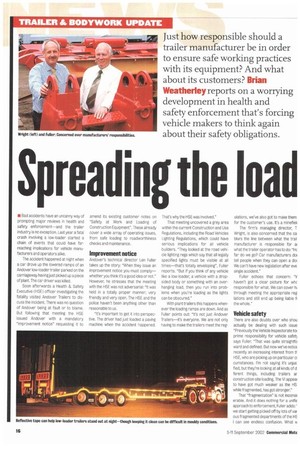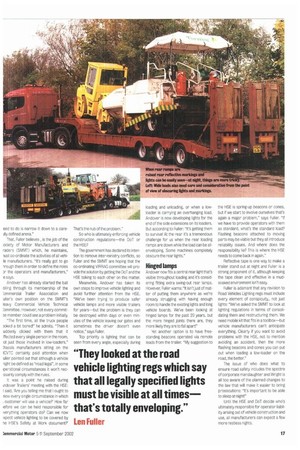Spreadin the load
Page 16

Page 17

If you've noticed an error in this article please click here to report it so we can fix it.
II Bad accidents have an uncanny way of orompting major reviews in health and safety enforcement—and the trailer industry is no exception. Last year a fatal crash involving a low-loader started a chain of events that could have farreaching implications for vehicle manufacturers and operators alike.
The accident happened at night when a car drove up the lowered ramps of an Andover low-loader trailer parked on the carriageway having just picked up a piece of plant. The car driver was killed.
Soon afterwards a Health & Safety Executive (HSE) officer investigating the fatality visited Andover Trailers to discuss the incident. There was no question of Andover being at fault or to blame. But following that meeting the HSE issued Andover with a mandatory "improvement notice" requesting it to amend its existing customer notes on "Safety at Work and Loading of Construction Equipment". These already cover a wide array of operating issues, from safe loading to roadworthiness checks and maintenance.
Improvement notice
Andover's technica director Len Fuller takes up the story: When they issue an improvement notice you must comply— whether you think its a good idea or not." However, he stresses that the meeting with the HSE was not adversarial: "It was held in a totally proper manner; very friendly and very open. The HSE and the police haven't been anything other than reasonable to us.
"It's important to get it into perspective. The driver had just loaded a paving machine when the accident happened. That's why the HSE was involved."
That meeting uncovered a grey area within the current Construction and Use Regulations, including the Road Vehicles Lighting Regulations, which could have serious implications for all vehicle builders. "They looked at the road vehicle lighting rags which say that all legally specified lights must be visible at all times—that's totally enveloping", Fuller reports. "But if you think of any vehicle like a low-loader, a vehicle with a dropsided body or something with an overhanging load, then you run into problems when you're loading as the lights can be obscured."
With plant trailers this happens whenever the loading ramps are down. And as Fuller points out: "It's not just Andover Trailers—it's everyone. We are not only having to make the trailers meet the reg
ulations, we've also got to make them for the customers use. It's a minefieli The firm's managing director, T Wright, is also concerned that the ca blurs the line between what the trail manufacturer is responsible for ai what the trailer operator has to do: "Hc far do we go? Car manufacturers do' tell people when they can open a do( We can't have new legislation after eve single accident."
Fuller echoes that concern: "V haven't got a clear picture for whc responsible for what. We can cover hi through meeting the appropriate reg lations and still end up being liable fi the whole."
Vehicle safety
There are also doubts over who shoe actually be dealing with such issue "Previously the Vehicle Inspectorate to( prime responsibility for vehicle safet says Fuller. "That was quite straightfo ward and defined. But now we've noticE recently an increasing interest from tt HSE, who are picking up on particular ci cumstances. I'm not saying it's unjus• fled, but they're looking at all kinds of d ferent things, including trailers ar construction site loading. The VI appeal to have got much weaker as the HS while fragmented, has got stronger."
That "fragmentation" is not inconsii erable. And it does nothing for a unifiE approach to enforcement, Fuller adds;' we start getting picked off by lots of vat ous fragmented departments of the HE I can see endless confusion. What v‘ eed to do is narrow it clown to a careilly defined arena."
That, Fuller believes , is the job of the .ociety of Motor Manufacturers and radars (SMMT) which, he maintains, lust co-ordinate the activities of all vehile manufacturers. "It's really got to go Tough them in order to define the roles r the operators and manufacturers," e says.
Andover has already started the ball oiling through its membership of the :oinmercial Trailer Association and ullers own position on the SMMT's leavy Commercial Vehicle Technical ;ornmittee, However, not every commitae member could see a problem initially.
"The first time, all the truck people )olied a bit bored!" he admits. "Then it uddenly clicked with them that it ,ffected every single person in the room, ot just those involved in low-loaders," ;hassis manufacturers sitting on the ICVTC certainly paid attention when uller pointed out that although a vehicle -light be defined as "road legal", in some iperational circumstances it won't necissarily comply with the rules.
It was a point he raised during
■ ndover Trailers' meeting with the HSE: I said, Are you telling me that I ought to now every single circumstance in which 'customer will use a vehicle?' How fa7lefore we can be held responsible for verything operators do? Can we now ixpect vehicle lighting to be covered by he IHSE's Safety at Work document?'
That's the nub of the problem."
So who is ultimately enforcing vehicle construction regulations—the DoT or the HSE?
The government has declared its intention to remove inter-ministry conflicts, so Fuller and the SMMT are hoping that the co-ordinating VIRRAG committee will provide the solution by getting the DoT and the HSE talking to each other on this matter.
Meanwhile, Andover has taken its own steps to improve vehicle lighting and avoid further attention from the HSE. "We've been trying to produce safer vehicle lamps and more visible trailers for years—but the problem is they can be destroyed within days or even minutes of the vehicle leaving our gates and sometimes the driver doesn't even notice," says Fuller.
Top priority is lighting that can be seer. from every angle, especially during loading and unloading, or when a lowloader is carrying an overhanging load. Andover is now developing lights for the end of the side extensions on its loaders. But according to Fuller: "It's getting them to survive! At the rear it's a tremendous challenge for us when the rear loading ramps are down while the load can be allenveloping. Some machines completely obscure the rear lights."
Hinged lamps
Andover now fits a central rear light that's visible throughout loading and it's considering fitting extra swing-out rear lamps. However, Fuller warns: "It isn't just of matter of putting them anywhere as we're already struggling with having enough room to handle the existing lights and long vehicle boards. We've been looking at hinged lamps for the past 20 years, but the more hinged joints there are, they more likely they are to fall apart!"
Yet another option is to have freestanding beacons operated via remote leads from the trailer, "My suggestion to tee HSE is spring-up beacons or cones, but if we start to involve ourselves that's again a major problem," says Fuller. "If we have to provide operators with them as standard, what's the standard load? Flashing beacons attached to moving parts may be viable but they all introduce reliability issues, And where does the responsibility lie? This is where the HSE needs to come back in again."
Reflective tape is one way to make a trailer stand out at night and Fuller is a strong proponent of it, although keeping the tape clean and effective in a mud' soaked environment isn't easy.
Fuller is adamant that any revision to Road Vehicles Lighting rags must include every element of conspicuity,, not just lights: "We've asked the SMMT to look at lighting regulations in terms of consolidating them and restructuring them. We need mobile kit that fits in a toolbox—but vehicle manufacturers can't anticipate everything. Clearly if you want to avoid problems with the HSE, not to mention avoiding an accident, then the more flashing beacons and cones you can put out when loading a low-loader On the road, the better."
The issue of who does what to ensure road safety includes the spectre of corporate manslaughter and Wright is all too aware of the planned changes to the law that will make it easier to bring prosecutions: "It's important to be able to sleep at night!"
Until the HSE and DOT decide who's ultimately responsible for operator liability arising out of vehicle construction and use, all manufacturers can expect a few more restless nights.




























































































































































